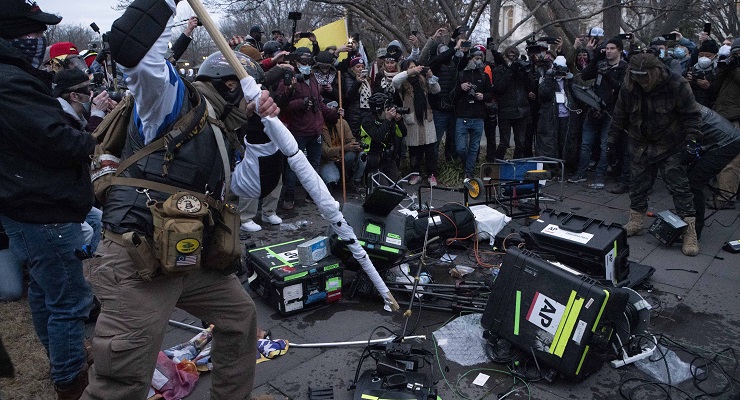
One year into COVID-19 and we’re seeing dangerous mutations of the virus, violent mass protests, anti-media domestic terrorism and hostile policing. Journalists around the world have essentially become war reporters in their own towns.
In Australia it’s like living in a parallel universe, but one where we can peer through space to see the Boschian nightmare playing out in real time.
Amongst all this, the media has been trying to do its job (we’re at work, not war as Washington Post editor Marty Baron cautioned just four years ago). But the worldwide authoritarian revolt, with its Trumpian “enemy of the people” rhetoric, has encouraged open war with the media.
This is particularly true in the United States, where journalists were targeted in the violent January 6 insurrection at the US Capitol. The words “murder the media” were scrawled on the Capitol door.
Already this year, three US journalists have been arrested covering mass protests. This follows the record 124 held in 2020.
They’re dealing with harassment and violence and the trauma of reporting on death and disaster as social systems threaten collapse. But they’re also grappling with that old saw: in war, truth is the first casualty.
In Australia, our resident media contrarians were happy to offer uninformed musings on border closures, quarantine and mask mandates. This culture-wars pushback against public health measures — led by the Herald Sun — often eclipsed attempts to effectively hold the government to account.
Fortunately, Australia’s state governments followed what Rupert Murdoch did (hunker down for the duration) rather than what much of his commentariat recommended (let ‘er rip for the sake of the economy).
Much of our media allowed itself to be marginalised during this time, misunderstanding something that makes Australia different to, say, the post-Reagan United States: Australians trust their public institutions.
We didn’t need the “gotcha” moments. We needed a fair and effective journalism of accountability.
At the same time, as a racist right-wing extremism was legitimised by elected officials through the English-speaking world, Australia’s media has been too slow to learn the critical difference between reporting and amplification.
Craft practices — those rules of thumb we jumble up as “objectivity” — are leaving Australia’s media largely on the outside looking in. Much reporting and discussion of white-nationalist extremism is tinged with a history-forgetting “it can’t happen here” confidence.
Outside Australia, the COVID disaster and the reality of extremist violence is collapsing that cool distancing. The media is facing the burning reality of authoritarian insurrection and overwhelmed health systems.
A freshly vaccinated Murdoch recently emerged from sheltering in the English countryside to accept a not-actually-official Australia Day honour. He released a video with some reflections on recent events.
The problem, per Murdoch, is not that the media (particularly his own) failed to provide a society in crisis with a reliable truth that counsels, warns and comforts. Rather, it was an “awful woke orthodoxy … a wave of censorship that seeks to silence conversation, to stifle debate and ultimately stop individuals and societies from realising their potential”.
It’s an old News Corp talking point. This time, it seems he was complaining about the social media crackdown on disinformation and misinformation, much of which has, in the US at least, been largely Fox-adjacent.
As Australia’s journalism code of ethics says, “respect for truth and the public’s right to information are fundamental principles of journalism”. The combined health and democratic crises in the US have forced social media platforms, belatedly and imperfectly, to grapple with those principles.
It’s not too late: those same principles can provide the journalism we need with a moral clarity that commits to its communities at times of crisis. Even in the Australian parallel universe.








I watch the PM’s press conferences and invariably my regard for Australian msm journalists drops.
That “Australian journalism code of ethics” (“respect for truth and the public’s right to information are fundamental principles of journalism”)?
Written before Rupert’s time – and redundant since?
Where to start on Oz media? Too polite, inward looking, clubby and socioculturally alike to most political and business elites while lacking skills of critical, science, data and now digital literacy to interrogate issues well.
Could be helped by journalists at least learning research methods and/or doing a post grad minor dissertation versus becoming an assets for politcla/corporate agitprop masquerading as news.
On this:
‘At the same time, as a racist right-wing extremism was legitimised by elected officials through the English-speaking world, Australia’s media has been too slow to learn the critical difference between reporting and amplification.’
Simple web based research via, yes, Google (especially logging out of com.au) would show rich, broad and deep research into right wing extremism and how it has spread over decades from the US into policy making and the mainstream, not just recent riots on Capitol Hill nor Christchurch shooter let alone some extremist rabble of the right.
Think too many gatekeepers in Oz are afraid of lifting the lid on anything versus a quiet comfortable life…..
Murdoch’s papers are among the worst of the ‘unwoke’ cancel culture provocateurs. They cancel until people leave the country for suggesting that maybe Anzac Day might glorify some bad memories of war, or get an SBS journalist sacked for twittering something that wasn’t straight from the unwoke book of memes.